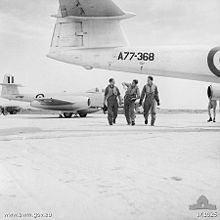- No. 77 Squadron RAAF
-
No. 77 Squadron 
Active 16 March 1942 Branch RAAF Role Ground attack Part of No. 81 Wing, Air Combat Group Garrison/HQ RAAF Base Williamtown Motto "Swift to Destroy" Insignia Callsign Despot (single aircraft)
Pirate (multi-aircraft)
Shogun (multi-aircraft)
Viking (multi-aircraft)
Warlock (multi-aircraft)No. 77 Squadron is a Royal Australian Air Force fighter squadron. The Squadron was formed in 1942 and currently operates F/A-18 Hornet aircraft from RAAF Base Williamtown.
Contents
History
No. 77 Squadron was formed at RAAF Base Pearce on 16 March 1942. Equipped with P-40 Kittyhawk aircraft the squadron was initially responsible for the defence of Perth. The squadron moved to Batchelor near Darwin in August, the first RAAF fighter squadron to be stationed in the area. The Squadron saw action defending Darwin from Japanese air raids and claimed its first 'kill' on 23 November 1942.
In February 1943 the squadron was deployed to Milne Bay in New Guinea. The Squadron flew escort and ground attack operations over New Guinea and the Solomon Islands until September 1944 when it moved to western New Guinea. The Squadron moved to Morotai in April 1945 and conducted ground attack missions over the Netherlands East Indies until June when it was redeployed to Labuan Island to support the Australian Army's operations in Borneo.
Following the Japanese surrender No. 77 Squadron was selected as part of Australia's contribution to the British Commonwealth Occupation Force and, after converting to P-51D Mustang fighters, arrived in Japan in February 1946. Occupation duties proved uneventful, and No. 77 Squadron was preparing to leave Japan for Australia when the Korean War broke out in June 1950.
No. 77 Squadron was committed to action over Korea as part of the United Nations forces, and flew its first ground attack sorties on 2 July 1950, making it the first non-United States UN unit to see action. No. 77 Squadron deployed to Korea in October to support the UN advance into North Korea but was withdrawn to Pusan in November in response to the Communist forces' counter-attack. The Squadron was withdrawn to Japan in April 1951 to re-equip with Gloster Meteor jet fighters and returned to action with these new aircraft in July. Following heavy losses from MiG-15 fighters No. 77 Squadron operated in the ground attack role from December 1951 until the end of the war; it remained in South Korea on garrison duties until returning to Australia in November 1954.
The Squadron was disbanded at RAAF Base Williamtown on 12 August 1956 but was reformed on 19 November 1956 equipped with CAC Sabres. In December 1958 the Squadron moved to RAAF Base Butterworth in Malaya where it flew ground attack missions against Communist guerrillas during the Malayan Emergency. The Squadron remained at Butterworth during the 1960s and served in the air defence role during the Indonesian Confrontation.
No. 77 Squadron returned to RAAF Base Williamtown in early 1969 to be re-equipped with Mirage III fighters which it operated in the air defence role. In January 1985 the squadron was temporarily equipped with Aermacchi MB-326 jet trainers which it operated until converting to F/A-18 Hornet fighter bombers in 1987. The Squadron operated a detachment of Pilatus PC-9 aircraft in the forward air control role from 2000 until 2003; this role is now filled by the Forward Air Control Development Unit. A detachment of four F/A-18s from No. 77 Squadron was deployed to protect the key US air base at Diego Garcia between December 2001 and February 2002 during the early phases of the invasion of Afghanistan.
Aircraft operated
- P-40 Kittyhawk (March 1942 – 1945)
- P-51D Mustang (Late 1945 – April 1951)
- Gloster Meteor (April 1951 – August 1956)
- CAC Sabre (November 1956 – July 1969)
- Mirage III (July 1969 – June 1987)
- Aermacchi MB-326 (January 1985 – June 1987)
- F/A-18 Hornet (June 1987–current)
- Pilatus PC-9 (2000–2003)
References
- RAAF Museum 77 Squadron
- Steve Eather (1995) Flying Squadrons of the Australian Defence Force. Aerospace Publications.
- RAAF Historical Section (1995), Units of the Royal Australian Air Force. A Concise History. Australian Government Publishing Service, Canberra.
Further reading
- Odgers, George (1968 (reprint)). Air War Against Japan 1943–1945. Australia in the War of 1939–1945. Series 3 – Air. Canberra: Australian War Memorial. http://www.awm.gov.au/histories/second_world_war/volume.asp?levelID=67913.
- Odgers, George (2008). Mr Double Seven : A Biography of Wing Commander Dick Cresswell, DFC. Tuggeranong: Air Power Development Centre. ISBN 9781920800307. http://airpower.airforce.gov.au/Publications/Details/228/Mr-Double-Seven.aspx.
Main series 1 · 2 · 3 · 4 · 5 · 6 · 7 · 8 · 9 · 10 · 11 · 12 · 13 · 14 · 15 · 20 · 21 · 22 · 23 · 24 · 25 · 26 · 27 · 28 · 29 · 30 · 31 · 32 · 33 · 34 · 35 · 36 · 37 · 38 · 40 · 41 · 42 · 43 · 60 · 66 · 67 · 71 · 73 · 75 · 76 · 77 · 78 · 79 · 80 · 82 · 83 · 84 · 85 · 86 · 87 · 92 · 93 · 94 · 99 · 100 · 102 · 107 · 292 · Fighter · Rescue and Communication · Seaplane · Berlin Air Lift
Article XV squadrons Joint Netherlands-Australian squadrons Categories:- RAAF squadrons
- Military units and formations established in 1942
- Military units and formations of Australia in the Korean War
- Military units and formations of Australia in World War II
Wikimedia Foundation. 2010.


